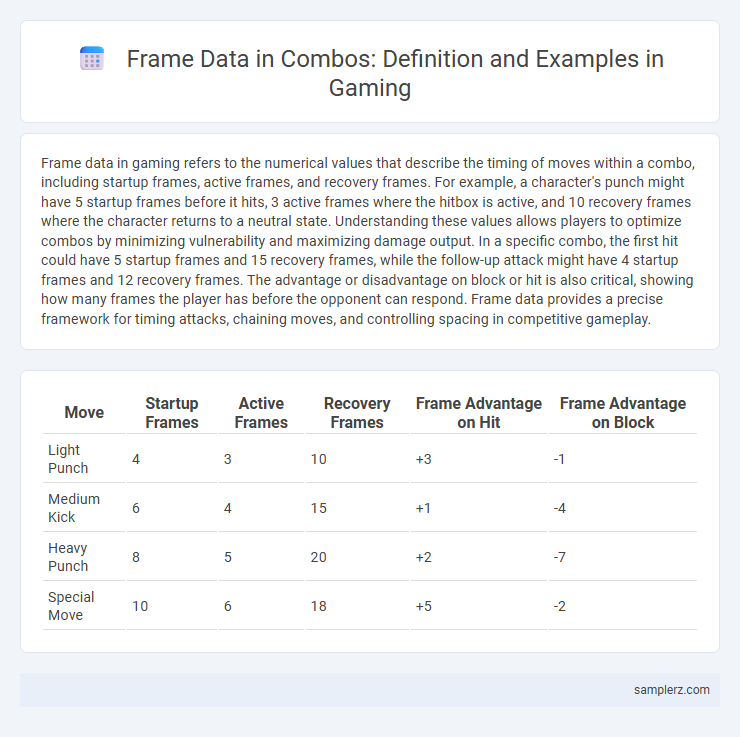Frame data in gaming refers to the numerical values that describe the timing of moves within a combo, including startup frames, active frames, and recovery frames. For example, a character's punch might have 5 startup frames before it hits, 3 active frames where the hitbox is active, and 10 recovery frames where the character returns to a neutral state. Understanding these values allows players to optimize combos by minimizing vulnerability and maximizing damage output. In a specific combo, the first hit could have 5 startup frames and 15 recovery frames, while the follow-up attack might have 4 startup frames and 12 recovery frames. The advantage or disadvantage on block or hit is also critical, showing how many frames the player has before the opponent can respond. Frame data provides a precise framework for timing attacks, chaining moves, and controlling spacing in competitive gameplay.
Table of Comparison
| Move | Startup Frames | Active Frames | Recovery Frames | Frame Advantage on Hit | Frame Advantage on Block |
|---|---|---|---|---|---|
| Light Punch | 4 | 3 | 10 | +3 | -1 |
| Medium Kick | 6 | 4 | 15 | +1 | -4 |
| Heavy Punch | 8 | 5 | 20 | +2 | -7 |
| Special Move | 10 | 6 | 18 | +5 | -2 |
Understanding Frame Data in Fighting Games
Frame data in fighting games details the number of frames moves take to execute, including startup, active, and recovery frames, essential for timing combos effectively. For example, if a character's jab has a 5-frame startup and a 3-frame recovery, understanding this allows players to chain moves with minimal gaps, maximizing damage output. Mastery of frame data enables precise execution and counters, providing a strategic edge in competitive play.
Key Terms: Startup, Active, Recovery Frames
Frame data in gaming combos crucially includes startup, active, and recovery frames which dictate the move's effectiveness and timing. Startup frames represent the initial period before the attack hits, active frames are when the move can connect with the opponent, and recovery frames cover the time needed to return to a neutral stance. Mastering these frame timings enables players to optimize combos for maximum damage and defensive safety.
Why Frame Data Matters in Combos
Frame data reveals the precise timing between moves in a combo, indicating which actions are safe, punishable, or guaranteed. Understanding frame advantage allows players to optimize their sequences for maximum damage and pressure while minimizing vulnerability. Mastery of frame data leads to more consistent execution and strategic decision-making during high-level gameplay.
Example Combo Breakdown with Frame Data
A typical fighting game combo includes specific frame data such as startup, active, and recovery frames, which determine the timing and effectiveness of each move. For example, a crouching light punch might have 3 startup frames, 2 active frames, and 5 recovery frames, allowing for quick follow-ups within a combo string. Mastery of frame data enables players to optimize combo execution and maximize damage output while minimizing vulnerability.
Hit Advantage and Combo Extensions Explained
Frame data in gaming combo analysis reveals hit advantage as the number of frames a player recovers before their opponent after a successful attack, crucial for timing follow-up moves. A positive hit advantage allows combo extensions by enabling additional hits before the opponent can retaliate or recover, increasing damage potential. Understanding frame data helps players optimize combos for maximum efficiency and control during matches.
Safe vs. Unsafe Strings: A Frame Data Perspective
Safe strings in fighting game combos ensure frame advantage, allowing the player to block or counterattack if the opponent retaliates. Unsafe strings result in frame disadvantage, leaving the player vulnerable to punishes due to slower recovery frames. Understanding frame data like startup, active, and recovery frames is crucial for distinguishing safe versus unsafe combo strings and optimizing offensive strategies.
Punishing with Frame Perfect Responses
Frame data in gaming is crucial for executing frame-perfect combos and punishing opponents' moves with precision. Understanding startup, active, and recovery frames allows players to identify unsafe moves and respond instantly with the fastest punishing attacks. Mastering frame data enhances reaction time and maximizes damage output by exploiting opponent vulnerabilities during their move recovery phase.
Character-Specific Frame Data Examples
Character-specific frame data in gaming combos details the precise startup, active, and recovery frames unique to each move of a character, crucial for timing and chaining attacks effectively. For instance, Ryu's Hadouken has a startup of 14 frames and an active window of 2 frames, while Ken's Shoryuken varies with versions having different frame advantages and hitbox properties. Understanding these nuances enables players to optimize combo execution and counterattack opportunities based on the character's frame data.
Tools and Resources for Frame Data Analysis
Frame data analysis tools like FrameData and Tekken Analyzer provide detailed input timing and startup frames for combos in fighting games. These resources allow players to optimize their attack sequences by examining recovery frames and block advantage for each move. Utilizing such comprehensive frame data databases improves reaction time and strategic decision-making during matches.
Tips for Practicing Combos Using Frame Data
Frame data reveals crucial timing information such as startup, active, and recovery frames for each move in a combo, enabling players to optimize execution and minimize vulnerabilities. Practicing combos with frame data encourages precise input timing and better understanding of frame advantage, which is essential for chaining moves effectively. Utilizing frame data guides players in adjusting combo sequences to maximize damage output while maintaining defensive safety.

example of frame data in combo Infographic
 samplerz.com
samplerz.com